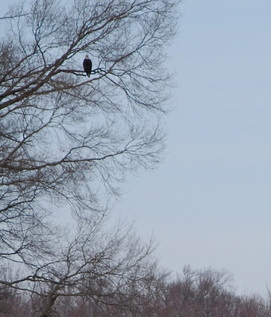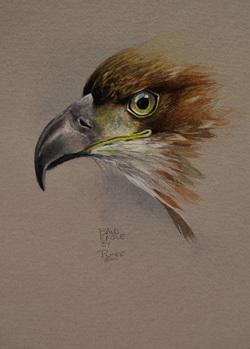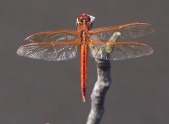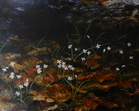| Kurt Plinke, Artist and Naturalist |
Between the Waters
life, Art and The Nature of things Between the Atlantic and the Chesapeake
 Recently, my wife mentioned that she had been seeing more and more bald eagles near the studio. At the time, I realized that I had also noticed an increase in eagle sightings. I told her I thought that it was probably the result of a combination of factors. One factor is the recent harvesting of crops in the fields near the studio. Bald eagles often scavenge, and a lot of tractor activity in a field leaves remains in its wake. Tractors run over mice, rabbits and other animals in the fields, and eagles will find them. Also, with no tall corn or bean plants standing, it is easier to see eagles and other scavengers as they congregate around a food source in the middle of a cut field. Along the same vain, as deer-hunting season gets into full swing, there are inevitable lost shots. Some deer, wounded by hunters, manage to topple where the hunter is unable to find them. Eagles, however, seem to be able to locate this bounty with ease. Along with vultures, eagles will mass around a deer carcass lying in a field. On my way to Dover last week, I saw seven eagles and uncountable turkey vultures congregated around a lost deer carcass. Eagles also are much easier to see as trees drop their leaves. Perched high in a gum tree along the river, an eagle would be invisible before the tree dropped its covering blanket of foliage. I have noticed, as well, that I have seen quite a few eagle pairs in recent weeks. Eagles begin to nest in mid-winter. It is possible that in this area, we are seeing the beginning of pair bonding activities. As eagles begin to locate their mates, or find new ones, they are much more active. Flying in pairs, they wheel about overhead. It always amazes me how such a big bird can be so agile in the skies. As the light hits them, adult eagles are amazingly easy to identify, their white head and tail glowing in contrast to their dark bodies. It may be that eagle numbers in general are also on the rise. It was not long ago that bald eagles were considered an endangered species. According to the Maryland Department of Natural Resources, the number of active nesting sites in Maryland had grown from a low of 39 nests in 1997 to 368 nest in 2004, the last year the study noted. As a part of that same series of reports, the number of wintering bald eagles increased in a similar manner. During the 1979 Wintering eagle survey, 44 bald eagles were noted. In 2008, that number had risen to 303 birds. That is an amazing increase. Whatever the reason, my wife is right. Eagles do seem to be everywhere. If you haven’t noticed, look around as you travel from place to place. If you look, I’ll bet that you will see large numbers of our national symbol all around you… flying over Easton town square, cruising low over a Dorchester field edge, massed in the middle of a newly plowed field near Chestertown, or just sitting like a sentinel on the bare branch of a tree.  OTHER NEWS: If you had not noticed, we’ve revamped Sewell Mills Studio & Gallery’s website, adding a lot of new content, features and an online store where paintings, prints and cards may be ordered. Take a moment and wander through… NEW WORKSHOPS SCHEDULED: A new series of workshops have also been scheduled in the studio. The first new workshop is set for Saturday, January 24th. We’ll be painting a Winter Wren on a goldenrod gall. It should be good... consider reserving a chair and attending. Christmas is coming soon…
0 Comments
Leave a Reply. |
What's News?Kurt Plinke: About Life, Art and the Nature of Things on the Eastern ShoreI write about things I've noticed, places I've been, plans I've made and paintings I've finished or am thinking about. Archives
February 2020
See recent naturalist observations I have posted on iNaturalist:
|
|
Sewell Mills Studio & Gallery
14210 Draper's Mill Road Greensboro, MD 21639 (410) 200-1743 kurtplinke@kurtplinke.com |
Rights to all images on this website, created by Kurt Plinke, remain the property of Kurt Plinke. Copying or use of these images is permissible only following written permission from Kurt Plinke. To use images for any purpose, contact kurtplinke@kurtplinke.com for permission.


